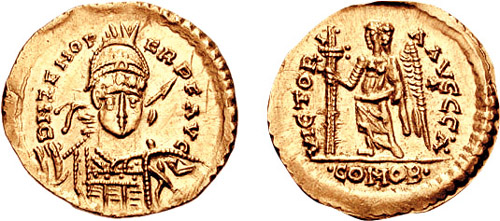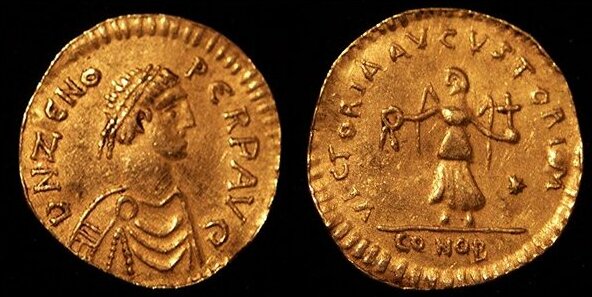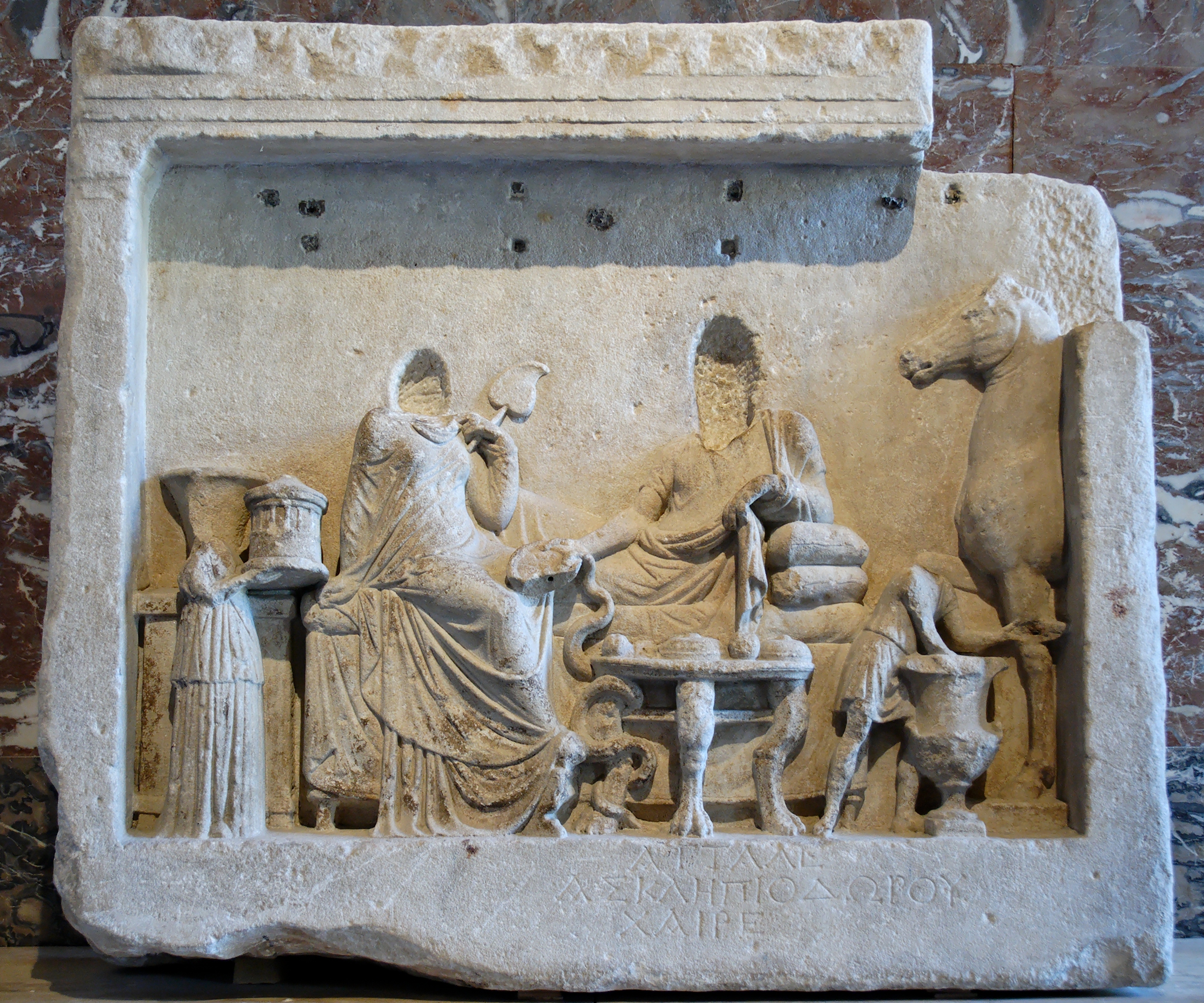|
Armatus
Flavius Armatus (died 477), also known as Harmatius, was an Eastern Roman military commander, ''magister militum'' under Emperors Leo I, Basiliscus and Zeno, and consul. He was instrumental in the rebellion of Basiliscus against Zeno, and in his subsequent fall. Origin and early career Armatus was a nephew of Basiliscus and of Empress Verina, the wife of Leo I. It is known that Armatus had a son, also named Basiliscus. During the last part of Emperor Leo's reign, Armatus, as ''magister militum per Thracias'', successfully quelled a revolt in Thrace, cutting off the hands of the Thracian prisoners and sending them to the rebels. It is possible that the rebels were men of the Thracian Goth Theodoric Strabo, a military commander under Leo, and hence this revolt would have been the one started by Strabo between the death of Aspar (471) and the end of Leo's rule (473).Suda, s.v. ''Ἁρμάτιος''. Rise of Basiliscus Armatus supported the rebellion of Basiliscus in 475, proba ... [...More Info...] [...Related Items...] OR: [Wikipedia] [Google] [Baidu] |
Basiliscus
Basiliscus ( grc-gre, Βασιλίσκος, Basilískos; died 476/477) was Eastern Roman emperor from 9 January 475 to August 476. He became in 464, under his brother-in-law, Emperor Leo (457–474). Basiliscus commanded the army for an invasion of the Vandal Kingdom in 468, which was defeated at the Battle of Cape Bon. There were accusations at the time that Basiliscus was bribed by Aspar, the ; many historians dismiss this, instead concluding that Basiliscus was either incompetent or foolish for accepting Vandal King Gaiseric's offer of a truce, which the latter used to construct fireships. Basiliscus's defeat cost the Eastern Empire of gold, causing the empire to hover above bankruptcy for 30 years. When Basiliscus returned to Constantinople, he sought refuge in the Church of St. Sophia. His sister, Empress Verina, secured him a pardon and he left the church to retire in Neapolis. When Emperor Leo died in 474, his grandson Emperor Leo II (474) took power, but soon di ... [...More Info...] [...Related Items...] OR: [Wikipedia] [Google] [Baidu] |
Zeno (emperor)
Zeno (; grc-gre, Ζήνων, Zénōn; c. 425 – 9 April 491) was Eastern Roman emperor from 474 to 475 and again from 476 to 491. Domestic revolts and religious dissension plagued his reign, which nevertheless succeeded to some extent in foreign issues. His reign saw the end of the Western Roman Empire following the deposition of Romulus Augustus and the death of Julius Nepos, but he was credited with contributing much to stabilising the Eastern Empire. In ecclesiastical history, Zeno is associated with the '' Henotikon'' or "instrument of union", promulgated by him and signed by all the Eastern bishops, with the design of solving the monophysite controversy. The Henotikon was widely unpopular and eventually abandoned under Justin I. Biography Rise to power Early life Zeno's original name was Tarasis, and more accurately ''Tarasikodissa'' in his native Isaurian language ( la, Trascalissaeus).The sources call him "Tarasicodissa Rousombladadiotes", and for this reason ... [...More Info...] [...Related Items...] OR: [Wikipedia] [Google] [Baidu] |
Zenonis
Aelia Zenonis (Greek: Ζηνονίς, 476/477) was Eastern Roman empress as the wife of Basiliscus. Her ancestry is unknown. Empress On 17 November 474, Leo II died and his father Zeno became sole emperor of the Eastern Roman Empire. The new reign was not particularly popular. Zeno was an Isaurian and therefore considered a barbarian. His origins caused antipathy towards his regime among the people of Constantinople. Zeno also secured positions of high authority for his fellow Isaurians. Furthermore, the strong Germanic portion of the military, led by Theodoric Strabo, disliked the Isaurian officers that Leo I brought to reduce his dependency on the Ostrogoths. Finally, Zeno alienated his fellow Isaurian general Illus. Basiliscus and Verina took advantage of the situation to form a conspiracy against their imperial in-law. In 475, a popular revolt against the emperor started within the capital. The uprising, received military support by Theodoric Strabo, Illus and Armatus and s ... [...More Info...] [...Related Items...] OR: [Wikipedia] [Google] [Baidu] |
Onoulphus
Onoulphus, also Onoulf, Unulf and Hunulf (died 493) was a general of the late fifth century of Scirian origin. He served as ''magister militum per Illyricum'' from 477 to 479 as a general of the Eastern Roman Empire, then afterwards was a general for his brother Odoacer, king of Italy, until their death. Biography Onoulphus was a Scirian; with his brother (or possibly half-brother), Odoacer, he was raised at the court of Attila, King of the Huns. Following the destruction of the Sciri, who had been incited to break their treaty with the Ostrogoths by Hunimund, king of the Swabians, Onoulphus with his father Edeko joined the Swabian side in the Battle of Bolia in the late 460s, where they were again defeated by the Ostrogoths under their king Theodemir. Onoulphus joined the Roman army in the 470s and rose through its ranks. He found a protector in the general Armatus, who had him appointed first ''comes'' and in 477, ''magister militum per Illyricum'', commander in chief of the Bal ... [...More Info...] [...Related Items...] OR: [Wikipedia] [Google] [Baidu] |
Basiliscus (Caesar)
Basiliscus was the only son of the Byzantine Empire, East Roman (Byzantine) military commander Armatus and briefly ''Caesar (title), caesar'' of the East Roman Empire in 476–477/8. In later life, he became a priest and finally bishop of Cyzicus. Biography Basiliscus' father Armatus played a crucial role in helping Emperor Zeno (r. 474–491) reclaim Constantinople from the usurper Basiliscus (whom Armatus had initially helped in his own rise to power) in 476. In exchange, Zeno crowned Armatus's son, still a boy, as ''Caesar (title), caesar'', effectively marking him out as his heir. It is possible that the young Basiliscus adopted the regnal name of Leo at this occasion, but this is disputed. Soon after, however, in 477 or 478, Armatus fell from imperial favour and was executed. Basiliscus was spared the same fate through the intervention of Empress Ariadne, but was forced to become a cleric. Initially he became a ''lector'' at Blachernae, and eventually he rose to become bish ... [...More Info...] [...Related Items...] OR: [Wikipedia] [Google] [Baidu] |
Verina
Aelia Verina (Greek: Βερίνα, died 484) was the Empress consort of Leo I of the Eastern Roman Empire. She was a sister of Basiliscus. Her daughter Ariadne was Empress consort of first Zeno and then Anastasius I. Verina was the maternal grandmother of Leo II. Family The origins of Verina and her brother Basiliscus are unknown. They are considered likely to have ancestry in the Balkans but nothing more specific is known. They are assumed to have at least one sister as a hagiography of Daniel the Stylite names a brother-in-law of Verina and Basiliscus as Zuzus. Stefan Krautschick in his historical work ''Zwei Aspekte des Jahres 476'' (1986) advanced a theory that the two siblings were related to Odoacer, the first barbarian King of Italy.Patrick Amory, ''Passage of "People and Identity in Ostrogothic Italy, 489-554" (2003)], page 282 The theory relies on passage 209.1 in the fragmentary chronicle of John of Antioch (chronicler), John of Antioch, a 7th-century monk. The chron ... [...More Info...] [...Related Items...] OR: [Wikipedia] [Google] [Baidu] |
Magister Militum
(Latin for "master of soldiers", plural ) was a top-level military command used in the later Roman Empire, dating from the reign of Constantine the Great. The term referred to the senior military officer (equivalent to a war theatre commander, the emperor remaining the supreme commander) of the empire. In Greek sources, the term is translated either as ''strategos'' or as ''stratelates''. Establishment and development of the command The title of ''magister militum'' was created in the 4th century, when the emperor Constantine the Great deprived the praetorian prefects of their military functions. Initially two posts were created, one as head of the infantry, as the ''magister peditum'' ("master of foot"), and one for the more prestigious cavalry, the '' magister equitum'' ("master of horse"). The latter title had existed since republican times, as the second-in-command to a Roman ''dictator''. Under Constantine's successors, the title was also established at a territorial ... [...More Info...] [...Related Items...] OR: [Wikipedia] [Google] [Baidu] |
Illus
Flavius Illus ( grc-gre, Ἴλλους or Ἰλλοῦς; died 488) was a Roman general, who played an important role in the reigns of the eastern emperors Zeno and Basiliscus. Illus supported the revolt of Basiliscus against Zeno, then switched sides, supporting the return of Zeno (475-476). Illus served Zeno well, defeating the usurper Marcianus, but came into conflict with the dowager empress Verina, and supported the revolt of Leontius. This rebellion failed and Illus was killed. Origins Illus ( grc-gre, Ἴλλους or ) was an Isaurian, but the time and place of his birth are unknown; he had a brother, called Trocundes. Illus is said to have held various offices under the Emperor Leo I (457—474), and to have been an intimate friend of Zeno, apparently before his accession. John Malalas considered Illus an uncle of Zeno. However, we first read of him in Zeno's reign, at a time during which he was hostile to Zeno. Under Basiliscus Basiliscus, brother of the dowage ... [...More Info...] [...Related Items...] OR: [Wikipedia] [Google] [Baidu] |
Magister Militum
(Latin for "master of soldiers", plural ) was a top-level military command used in the later Roman Empire, dating from the reign of Constantine the Great. The term referred to the senior military officer (equivalent to a war theatre commander, the emperor remaining the supreme commander) of the empire. In Greek sources, the term is translated either as ''strategos'' or as ''stratelates''. Establishment and development of the command The title of ''magister militum'' was created in the 4th century, when the emperor Constantine the Great deprived the praetorian prefects of their military functions. Initially two posts were created, one as head of the infantry, as the ''magister peditum'' ("master of foot"), and one for the more prestigious cavalry, the '' magister equitum'' ("master of horse"). The latter title had existed since republican times, as the second-in-command to a Roman ''dictator''. Under Constantine's successors, the title was also established at a territorial ... [...More Info...] [...Related Items...] OR: [Wikipedia] [Google] [Baidu] |
Theodoric Strabo
Theodoric (or Theoderic) Strabo ( la, Theodericus; died 481) was a Gothic chieftain who was involved in the politics of the Eastern Roman Empire during the reigns of Emperors Leo I, Zeno and Basiliscus. He was a rival for the leadership of the Ostrogoths with his kinsman Theoderic the Great, who would ultimately supplant him. Background Theodoric called ''Strabo'', son of Triarius, was a chieftain of the Thracian Goths (Thervingi, Bastarnae and Roxolane in Getea and Peuce island in the Danube delta); he had two brothers. The wife of the Alan general Aspar was his sister. Strabo had a wife, Sigilda, and a son called Recitach. He was a contemporary of the more famous Theodoric the Amal, who was a Moesian Goth of the royal Amal family, and who would become known as Theoderic the Great. Around 459, he is attested as in friendly relationship with the Byzantine Empire, possibly one of the ''foederati'', and receiving an annual subsidy from the Byzantines.Martindale. Under Leo I ... [...More Info...] [...Related Items...] OR: [Wikipedia] [Google] [Baidu] |
Cyzicus
Cyzicus (; grc, Κύζικος ''Kúzikos''; ota, آیدینجق, ''Aydıncıḳ'') was an ancient Greek town in Mysia in Anatolia in the current Balıkesir Province of Turkey. It was located on the shoreward side of the present Kapıdağ Peninsula (the classical Arctonnesus), a tombolo which is said to have originally been an island in the Sea of Marmara only to be connected to the mainland in historic times either by artificial means or an earthquake. The site of Cyzicus, located on the Erdek and Bandırma roads, is protected by Turkey's Ministry of Culture. History Ancient The city was said to have been founded by Pelasgians from Thessaly, according to tradition at the coming of the Argonauts; later it received many colonies from Miletus, allegedly in 756 BC, but its importance began near the end of the Peloponnesian War when the conflict centered on the sea routes connecting Greece to the Black Sea. At this time, the cities of Athens and Miletus diminished in impo ... [...More Info...] [...Related Items...] OR: [Wikipedia] [Google] [Baidu] |





